Last updated on October 31st, 2024
Featured image: Views of Balcon de Zocalo in Mexico City | Photo by Karen Gershowitz
Six places not to miss in Mexico City
by Karen Gershowitz
No trip to Mexico is complete without visiting Mexico City, a sprawling metropolis with a population of nearly 22 million. I was fortunate to have a personal guide to the city. Sophia and I met in New Orleans last year. Sophia is a Mexico City native who is knowledgeable and enthusiastic about her city. I learned and saw more of Mexico City and its history than I had in all my previous times in the country.
What not to miss in Mexico City
1. The National Museum of Anthropology
Our first stop was the world-class National Museum of Anthropology, located in Chapultepec Park. Using maps and museum artifacts, Sophia explained the origins of Mexico City. The city is situated on a former lake. As a result, the ground is unstable, causing earthquakes to do more damage than would be expected. And the city is sinking, an inch or more a year. Later, while we walked through the city, she pointed out many buildings that are tilted because of their unstable watery foundation. While at the museum, we looked at the famous Aztec Sun Stone and other Aztec artifacts. As Sophia noted, it would be easy to spend a couple of days at the museum. But there is so much more to see in the city that we continued on.
2. Chapultepec Park
Chapultepec Park is one of the largest city parks in the world. In addition to the National Museum of Anthropology, the park is home to Chapultepec Castle. Perched atop a hill, it offers stunning panoramic views of the city. Inside is a museum dedicated to Mexican history. Also within the park are the Museum of Modern Art, the Tamayo Museum of Contemporary Art, a zoo, several lakes, botanical gardens, and numerous walking paths and picnic areas. On any given weekend, it can feel as though half of the population has descended on the park.
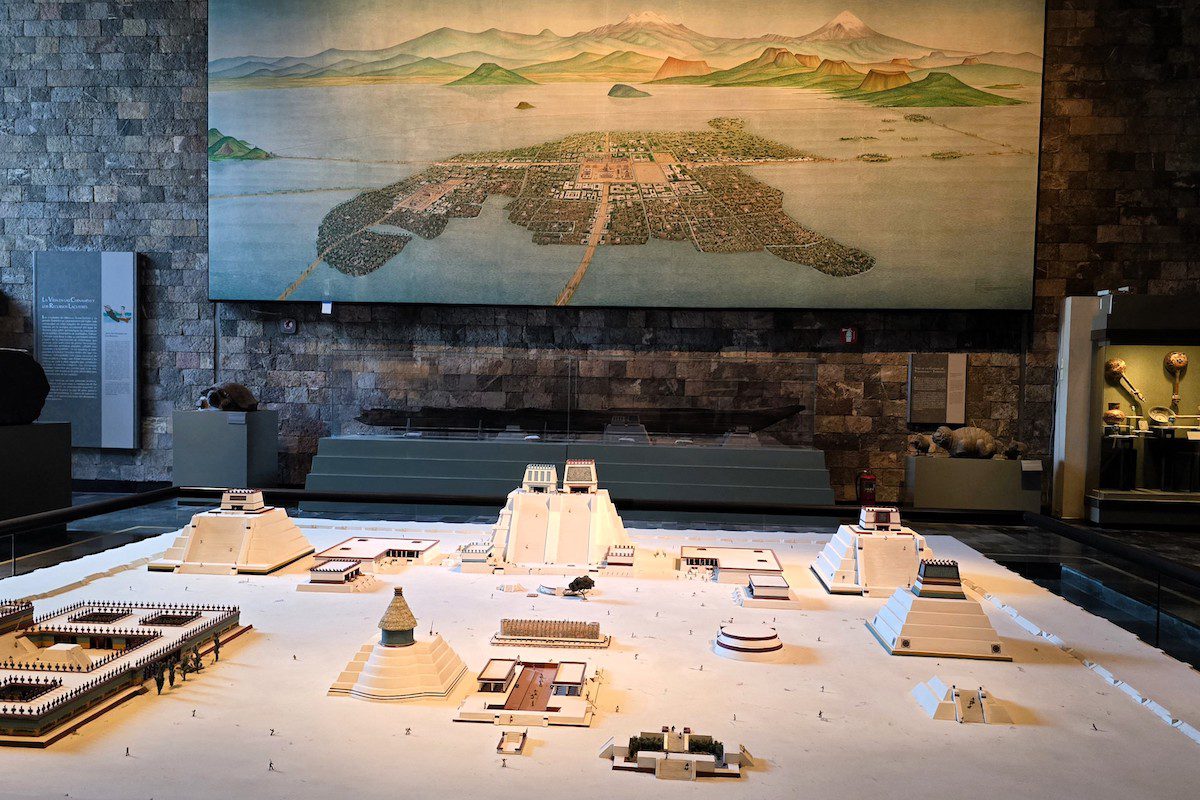
3. Palacio de Bellas Artes
Leaving the museum, Sophia and I headed downtown. Our first stop was the Palacio de Bellas Artes, an architectural marvel known for its Art Nouveau and Art Deco styles. The interior features murals by Diego Rivera and other famous Mexican artists. Sophia told me the theatre has an enormous and stunning glass curtain designed by Louis Tiffany. It depicts the Valley of Mexico’s volcanoes and is displayed only before performances by the Ballet Folklorico de Mexico.
4. Sanborn’s department store
A short walk away is the original Sanborn’s department store. A bit like Woolworths in its heyday, you can buy anything there. It’s jokingly referred to as the “emergency store.” But that’s not the reason we visited. The exterior is covered with lovely tiles and inside the décor is glorious. We stopped for a fruit juice in the main dining room. The waitresses wear uniforms that date back many decades. They’ve got colourful, striped flounced skirts covered by an apron, white lacy blouses, and a colourful pointed collar. The restaurant walls are decorated with murals and the whole place makes you feel as though you’ve stepped back in time.
5. The Central Post Office
We walked through the center of the city, admiring buildings reminiscent of Europe. This isn’t surprising, given the centuries of Spanish and French influence in the city. The most spectacular and interesting building is the central post office. Apart from the beauty of the building, both outside and inside, its role in immigration to Mexico is a testament to human resiliency. From the late 1800s to early 1900s many thousands of people immigrated from Europe to Mexico City. The first wave, usually the eldest son, would find work and a place to live. Once settled, they would send for other family members to join them. But when the second wave of immigrants arrived and went to the return address on the envelope, they found themselves at the central post office. It was the most reliable place to receive mail from home. Most immigrants visited the post office daily, hoping for a letter from home. When the new immigrants came to the post office, they waited around, hoping to see their relatives. If they didn’t, at least they would meet people who spoke their language. Eventually, they would connect with family.
6. The Zócalo
After the post office, we headed to the Zócalo, one of the largest public squares in the world. On one side of the Zócalo is the Metropolitan Cathedral, a massive structure that took nearly 250 years to complete. Across from it is the National Palace, which houses the offices of Mexico’s President. It is decorated with murals by Diego Rivera depicting Mexico’s history from the pre-Columbian era to the Mexican Revolution.
Our destination was Balcon de Zócalo, a Michelin-rated rooftop restaurant with a breathtaking view. We were seated at a table looking directly at the Cathedral. While we were eating, we could see clouds moving in over the city. There was a torrential rainstorm, as there is most summer afternoons. The staff lowered plastic curtains to prevent us from getting soaked. By the time we’d finished our meal and were ready to leave, the rain had stopped.
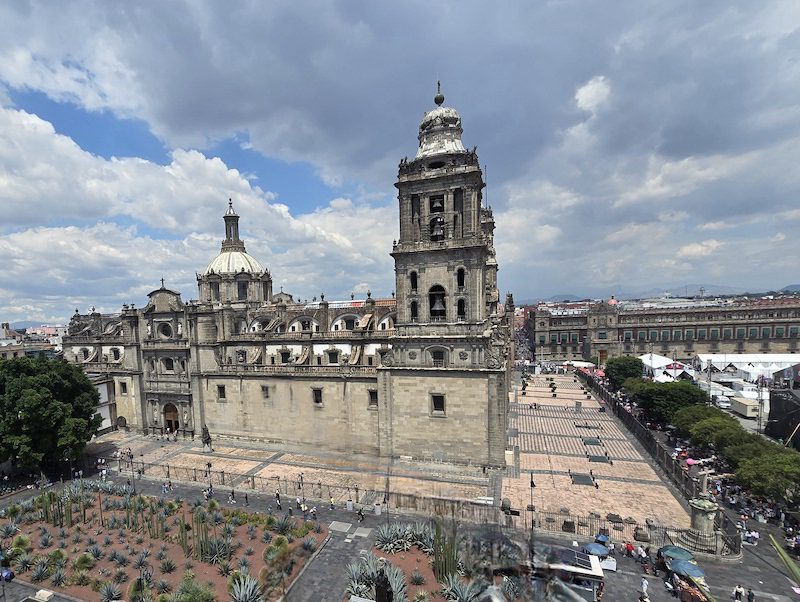
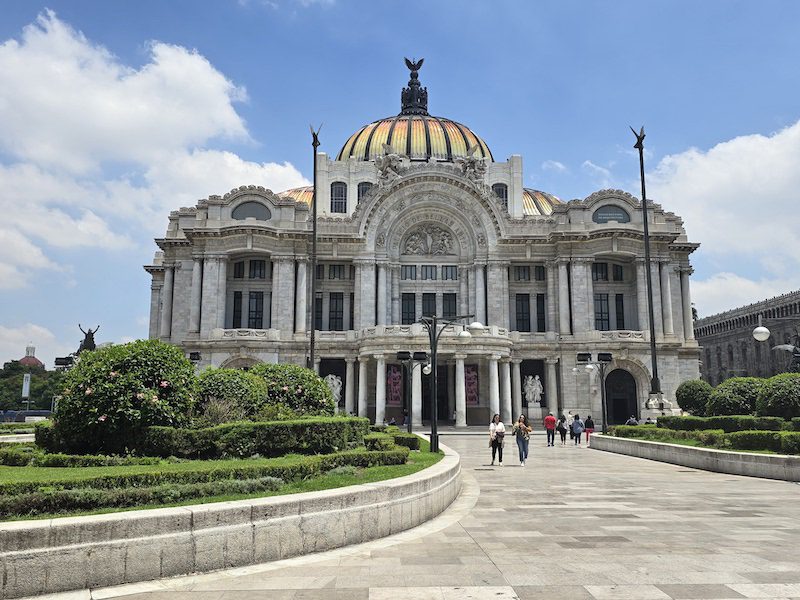
The Palacio de Bellas Artes in Mexico City / Photo by Karen Gershowitz
Mexico City’s Vibrant Neighborhoods
Each of Mexico City’s neighborhoods, or “colonias” has its own distinct character and charm. Coyoacán is the bohemian heart of the city. It is famous for its vibrant arts scene and for being the home of Frida Kahlo. In its lively central square, there are performers, craft vendors and, if you like people watching, loads of families, couples arm-in-arm strolling, and dog walkers. This is a very dog-friendly area. Make sure to visit Casa Azul, the Blue House, where Kahlo and Diego Rivera lived and worked. It offers an intimate look into the life of one of Mexico’s most iconic artists.
Culinary Adventures in Xochimilco
In Mexico, food is as much a part of the culture as it is in Italy. I spent a full day exploring food, agriculture, and nature in Xochimilco, an area at the extreme south end of Mexico City. To see this area, I took a food tour with Culinary Backstreets.
There were five of us on the tour. Our guide, Victor, met us at a café. Over coffee and pastries, he explained the history of Mexico City, the arrival of new cultures, and how they all contributed to modern Mexican cooking.
From there, we boarded a van and headed to Xochimilco. For the next three hours, we made our way through the market, stopping frequently to taste local foods, spices, and preparations. Our first bite was a churro. That was quickly followed by two different tamales, each wrapped in a corn husk.
There were far too many tastings to describe each one, but they were all delicious, all different, and I didn’t know about most of them. Victor did a wonderful job explaining what we were eating and why it is culturally important. A few of the highlights: tacos stuffed with squash blossoms and cheese, freshly made tortillas with salt (we watched them being made), and an “everything” taco that was amazing. By the end of the tastings, I was begging for mercy. I’d eaten enough for a couple of days.
I try to go to markets everywhere I travel and had spent time in other markets in Mexico. This one is special. It’s huge. The produce couldn’t be fresher or more beautifully displayed. When we walked through the fish and meat areas there wasn’t a whiff of anything. The shopkeepers were friendly and seemed happy we were interested.
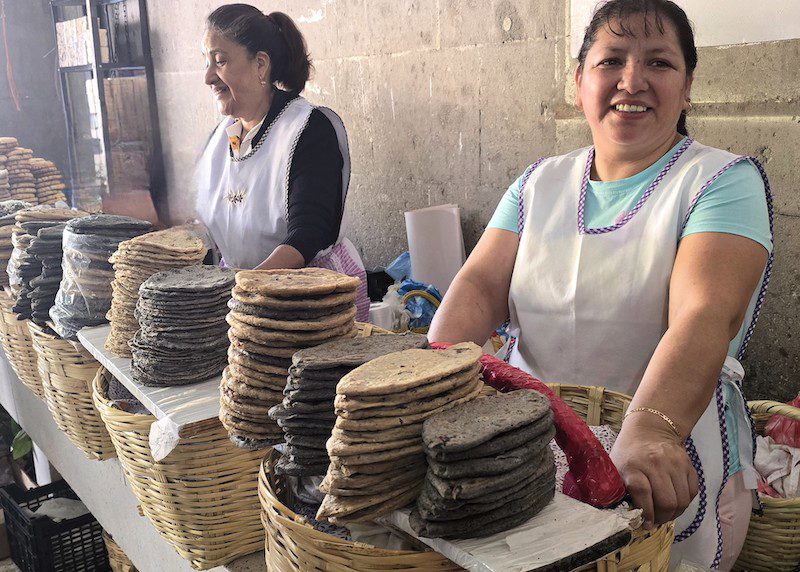
In the Xochimilco market / Photo by Karen Gershowitz
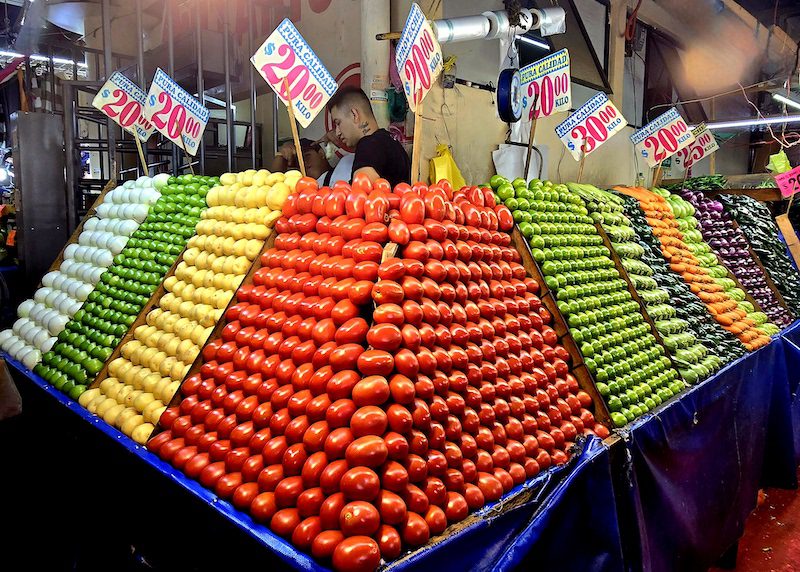
Display in the Xochmilco market / Photo by Karen Gershowitz
The area is tranquil and beautiful, teeming with birds and lush vegetation. On weekends, however, beware—the peaceful atmosphere disappears as party boats fill the waters. The occupants drink and become raucous.
Victor explained traditional farming methods that have all but disappeared, with individual farmers replaced by large agribusiness. One of the reasons Culinary Backstreets runs this tour is to make people aware of what is happening in the area. They’d like to see these methods revived; the traditional methods are good for the environment and produce more flavorful foods. The first step is to bring awareness of the problem.
Read More: Where to Stay in Mexico City

In the Xochmilco Nature Preserve / Photo by Karen Gershowitz
If you go to Mexico City
Transportation
Getting to Mexico City: Mexico City is well-connected to major cities across North America, with frequent direct flights available from New York, Los Angeles, Chicago, and Toronto. Most international flights land at Mexico City International Airport (Benito Juárez International Airport), which is located just a short drive from the city center. From the airport, you can easily reach your accommodation by taxi, ride-share services like Uber, or authorized airport shuttle services. Click here to search flight prices.
Transportation within Mexico City: The Metro is the most efficient and affordable way to get around. There are numerous lines covering most areas of the city. Taxis and ride-sharing apps like Uber are also widely available and inexpensive.
Accommodation
Central Mexico offers a wide range of accommodation options to suit every budget. In Mexico City, you’ll find everything from luxurious hotels in Polanco and Roma to charming boutique hotels in Coyoacán. Click here to find a place to stay.
Safety in Central Mexico
Like any travel destination, you should follow common-sense precautions. But by adhering to a few simple steps it can be a safe and enjoyable experience. Read more about our recommended safety products here.
While certain areas of Mexico City may have higher crime rates, particularly related to petty theft or robbery, most visitors have trouble-free trips. If you stay in well-traveled areas, you are unlikely to encounter any problems. Avoid displaying valuable items like jewelry or expensive electronics in public. Use secure transportation options, such as reputable taxis or ride-sharing services. I used Uber numerous times and felt very safe.
Health issues, such as waterborne illnesses, can be mitigated by drinking bottled water and avoiding raw fruits and vegetables unless they have been peeled.
Local Etiquette: Mexican dining culture typically follows a later schedule than in North America. Lunch, the main meal of the day, is usually served between 2:00 PM and 4:00 PM, while dinner is often enjoyed between 8:00 PM and 10:00 PM. If you’re dining out, be prepared for a more relaxed pace, as meals are seen as a time to socialize and enjoy the company of friends and family.
Tipping: Tipping is customary in Mexico and is generally expected in restaurants, bars, and for services such as taxis and hotel staff. The standard tip in restaurants is around 10-15% of the bill. For taxi drivers, rounding up the fare or leaving a small tip is appreciated. Hotel staff, such as bellhops and housekeeping, typically receive around 20-50 pesos per service, depending on the level of assistance provided.
Weather: Central Mexico enjoys a pleasant climate throughout the year, thanks to its elevation. Mexico City and the surrounding areas experience mild temperatures, with averages ranging from 60°F to 75°F (15°C to 24°C). The dry season runs from November to April, making it an ideal time for travel, with clear skies and cooler temperatures. The rainy season, from May to October, brings more humidity and afternoon showers, but mornings are often clear and sunny, making it still possible to enjoy outdoor activities.

More to Discover From Mexico
Swimming with Whale Sharks in Mexico’s Galapagos: Adventures in La Paz, Baja California Sur
A once-in-a-lifetime experience swimming with whale sharks in La Paz, Mexico, reminds us to trust ourselves and the universe.
Women Are Keeping Traditions Alive in Chihuahua, Mexico
Featured image: The stunning Copper Canyon (Barrancas del Cobre), has a gulf four times bigger than the Grand Canyon | Photo by wirestock on EnvatoChihuahua has some of Mexico's most spectacular natural formations by Kathy Buckworth At the age of 61, I was excited to...
Hidden Gems and Small Villages for Women to Explore Near Mexico City
Vibrant villages in Ixtapan de la Sal, Tecometepec, Taxco, Toluca and Metepec offer women travellers a deeper connection to Mexico.

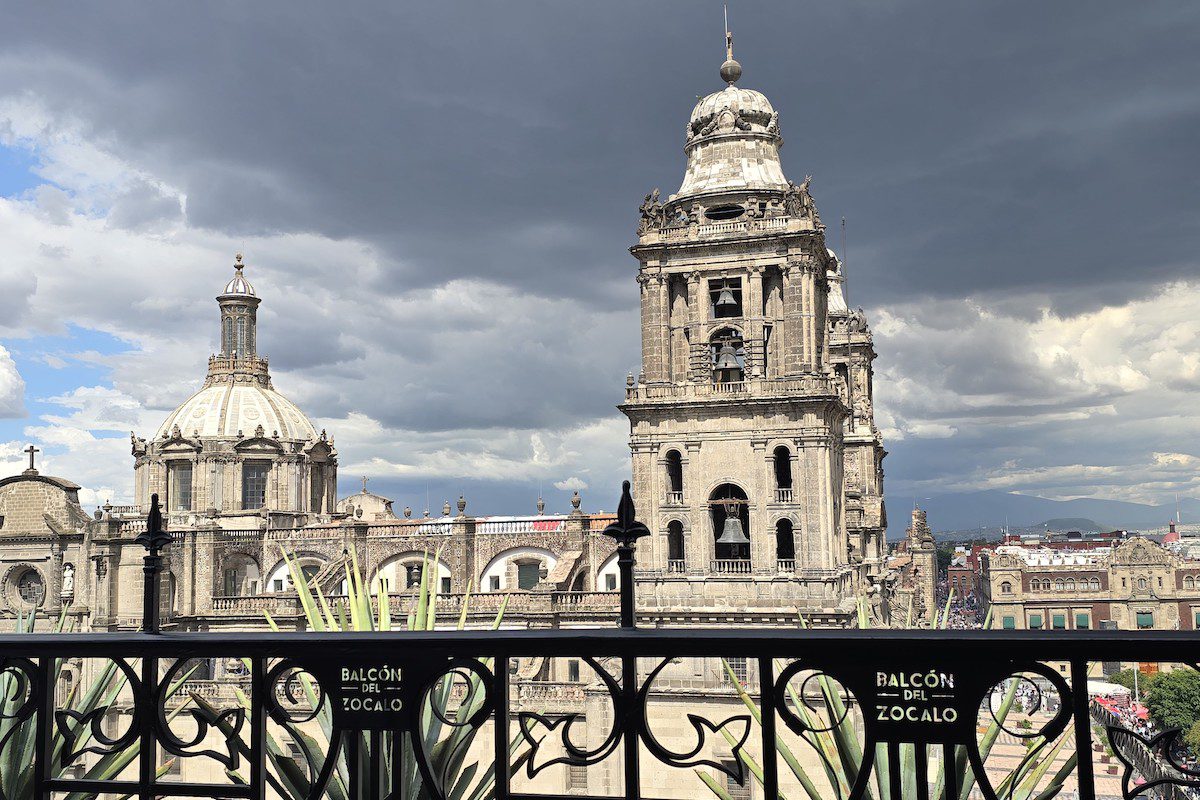



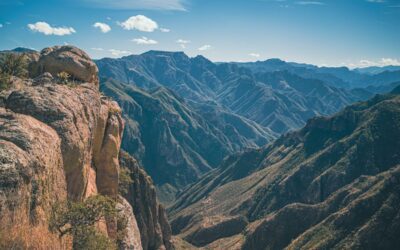

0 Comments
We always strive to use real photos from our own adventures, provided by the guest writer or from our personal travels. However, in some cases, due to photo quality, we must use stock photography. If you have any questions about the photography please let us know.
Disclaimer: We are so happy that you are checking out this page right now! We only recommend things that are suggested by our community, or through our own experience, that we believe will be helpful and practical for you. Some of our pages contain links, which means we’re part of an affiliate program for the product being mentioned. Should you decide to purchase a product using a link from on our site, JourneyWoman may earn a small commission from the retailer, which helps us maintain our beautiful website. JourneyWoman is an Amazon Associate and earns from qualifying purchases. Thank you!
We want to hear what you think about this article, and we welcome any updates or changes to improve it. You can comment below, or send an email to us at [email protected].